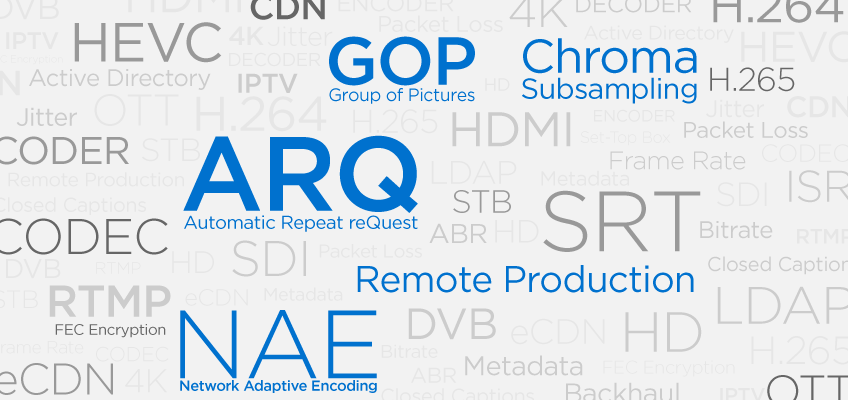Confused by HEVC and H.264 video compression? Don’t know the difference between SRT and RTMP? Check out our newly updated streaming video glossary, designed to shed some light on some of the most important terminology behind video encoding and streaming video. No matter what your knowledge level, we’ve got you covered with clear and concise explanations of some of the most common industry terms as well as Haivision specific features.
In this most recent update to the glossary, we’ve added definitions for the following terms:
Automatic Repeat reQuest (ARQ)
In past blogs, we’ve affectionately referred to ARQ as the “finder of the lost packets.” ARQ is an error correction technique which is well suited to live video streams or very large files. Read more.
Chroma Subsampling
Here’s an interesting fact: in HEVC and H.264 encoders, chroma subsampling can reduce the storage size and bandwidth requirements of uncompressed video by up to 30-50 percent. Read more to find out how this compression method is designed to take advantage of the human eye’s higher sensitivity to variations in luminance compared to color.
Group of Pictures (GOP)
In video encoding, GOP is the term used for grouping a series of frames into sequences. By processing and compressing GOPs instead of individual frames, file sizes and stream bitrates can be significantly reduced. Read more to learn about the differences between I, P and B frames.
Network Adaptive Encoding (NAE)
A Haivision innovation, Network Adaptive Encoding helps ensure that video streams never fail, even when faced with significant bandwidth limitations. Read more about it here. We think NAE is such a powerful feature, we’ve even written a white paper about it – Network Adaptive Encoding: Intelligent Encoding for Low Latency Streaming.
Remote Production
A hot topic in the broadcast industry for the past few years, remote production is proving to be an increasingly popular solution to meet the growing demand for live content. Read the full explanation of what remote production entails here. Thanks to the latest technological innovations, broadcasters using a remote production approach are able to do more with less, creating more live, high quality content while maximizing efficiencies. Read more in our white paper – Remote Production: Synchronizing Video Sources Over the Internet.
If you’re looking for clarity on some of the most common terms used in streaming video, check out our glossary for definitions, illustrations and additional resources that might be of interest.

